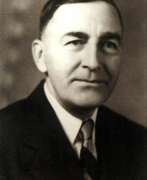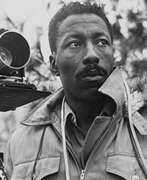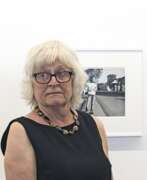USA Black & white photo
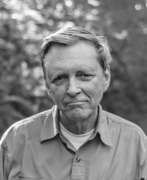

Robert Adams is an acclaimed American photographer known for his profound exploration of the American West's changing landscapes. His work, which gained prominence in the mid-1970s, delves into the tension between the natural beauty of the land and the marks of human encroachment. Adams's photography is a reflection on humanity's relationship with the environment, offering both a critique and a celebration of the landscape.
Robert Adams's notable series, such as "Turning Back" and "The New West," showcase his unique perspective on environmental and urban development issues. His work extends beyond just capturing images; it is a thoughtful commentary on the balance between nature and industrialization. His photographs, often devoid of people, focus on the land itself, telling a story of alteration and resilience.
Exhibitions of Adams's work, such as "American Silence: The Photographs of Robert Adams" at the National Gallery of Art, provide insight into his 50-year career and his ability to capture the silent yet profound narratives of the American landscape. His pieces are part of major collections and have been featured in numerous retrospectives, underlining his influence and significance in the world of photography.
For art collectors and enthusiasts, Robert Adams's work offers a poignant perspective on the American West, blending aesthetic beauty with critical environmental commentary. Engaging with his work invites reflection on our interaction with the landscape and our role in shaping the environment.
If you're interested in staying updated on Robert Adams's work and exhibitions, consider subscribing to newsletters from galleries and museums that feature his art. This way, you'll be informed about new displays of his work and opportunities to engage with his insightful perspectives on the American West.


Ansel Easton Adams was an American photographer and environmentalist, celebrated for his black-and-white images of the American West, particularly Yosemite National Park. His profound connection with nature was not only the subject of his art but also the essence of his environmental advocacy, earning him a revered place in both the art and conservation worlds.
Ansel Adams' early exposure to the beauty of nature and a supportive family environment nurtured his dual interests in music and photography. His photographic journey began with a simple Kodak Box Brownie camera, which he used during his early visits to Yosemite, a place that would become the central theme of his life's work. Ansel Adams' dedication to photography and the environment was interwoven, as he utilized his art to advocate for the conservation of America's natural landscapes.
In the 1930s, Adams co-founded Group f/64, advocating for photographic purity and sharpness of focus, principles that would define his work. His role in establishing the photography department at the Museum of Modern Art in New York underscored his commitment to elevating photography as a respected art form. Ansel Adams' work has been exhibited in prestigious institutions such as the Smithsonian American Art Museum and MoMA, showcasing his contributions to American art and environmentalism.
For collectors and art experts, Ansel Adams' legacy transcends his iconic images; it lies in his ability to merge aesthetic excellence with a passionate message of environmental stewardship. His photographs not only capture the grandeur of landscapes but also serve as a timeless call to preserve the natural world.
To delve deeper into the world of Ansel Easton Adams and stay updated on new product sales and auction events related to his work, signing up for updates is a step toward embracing the heritage of a pivotal figure in art and environmental advocacy.
Join our community of art and antique enthusiasts to honor Adams' vision and ensure his message continues to inspire future generations.


Ike Altgens, born James William Altgens, was an American photojournalist, photo editor and reporter for the Associated Press (AP).
After graduating from North Dallas High School, James joined the Associated Press, first as a reporter and in 1940 he was assigned to the photojournalism staff. He served in the U.S. Coast Guard during World War II and returned to the Associated Press in 1945 as a photographer, working as an editor and part-time actor and model.
On November 22, 1963, Altgens was assigned to photograph President John F. Kennedy during his visit to Dallas. And as fate would have it, he was able to take historic photos of the Kennedy assassination, which appeared in newspapers around the world the next day.
Altgens left the Associated Press in 1979, then worked on advertising for Ford Motor Company. On December 12, 1995, James Altgens and his wife were found dead in different rooms of their home in Dallas. According to the investigation, the cause of their deaths was carbon monoxide poisoning due to a faulty furnace.


Ellen Auerbach, born Ellen Rosenberg, is an American photographer of German-Jewish descent and a master of avant-garde photography.
Ellen studied at the Baden State School of Art and continued her studies at the Academy of Fine Arts in Stuttgart before meeting photographer Greta Stern (1904-1999) in Berlin. Together they opened Ringl+pit, a photography and design studio specializing in advertising, fashion and portrait photography. The photographer is most remembered for her groundbreaking work at this particular studio. Ellen, who also experimented with film, made two short black-and-white films.
In 1933, Ellen emigrated to Palestine and opened a children's portrait studio there. A few years later she moved with her husband Walter Auerbach to the United States, where she worked in a private art collection, taught photography, made films and photographs to study children's behavior, and worked as an educational therapist.
The Ringl+pit works and photographic oeuvre of Ellen Auerbach and Greta Stern were rediscovered in the 1980s, and a series of solo and group exhibitions in the United States and Germany followed.


Lillian Bassman was an American photographer and artist.
A magazine art director and fashion photographer, she became famous in the 1940s and '50s for her high-contrast, dreamy portraits of sylph-like models. Bassman's unique graphic style of photography illustrates the feminine mystique and glamour, as well as the boldness of an artist who blurs the lines between fashion photography and fine art. Working as art director for Bazaar magazine in 1945, she helped launch the careers of many of the century's most famous photographers.
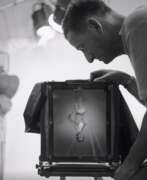

Erwin Blumenfeld was a German-born photographer and artist who is best known for his fashion photography and experimental work in the mid-20th century. He was began his career as an artist, working in painting, drawing, and collage.
In the 1930s, Blumenfeld fled Germany and settled in Paris, where he became a successful fashion photographer. He worked for Vogue and other high-profile magazines, creating iconic images of models and celebrities such as Marilyn Monroe, Elizabeth Taylor, and Grace Kelly.
Blumenfeld was also known for his experimental and avant-garde work, which often involved techniques such as photomontage, solarization, and multiple exposures. He saw photography as a means of artistic expression and used it to explore ideas about identity, beauty, and the nature of reality.
Blumenfeld's legacy as an artist and photographer continues to influence contemporary fashion and art. His innovative techniques and distinctive style continue to inspire new generations of artists, and his work is recognized as a significant contribution to the history of photography.


Margaret Bourke-White was an American photographer and photojournalist. She studied photography at the Clarence H. White School of Photography. White, where she developed her trademark style using dramatic angles and strong contrasts of light and shadow.
Burke-White was one of the first women photographers to work for Life magazine, and her images became synonymous with the magazine's coverage of major world events such as World War II and the Korean War. She was also the first woman photographer to work in war zones during World War II, where she captured powerful images of warfare and its impact on civilians.
In addition to war photography, Bourke-White also documented the Great Depression in the United States and was one of the few photographers to gain access to the Soviet Union in the 1930s where she documented Soviet industrialization and the lives of ordinary people.
Bourke-White's work was known for its powerful impact and stark realism. She often risked her safety to get the perfect shot and her images continue to inspire photographers today. She published several books of her work, including 'Eyes on Russia' and 'Dear Fatherland, Rest in Peace'.
Bourke-White left behind a legacy as one of the greatest photojournalists of the 20th century.


Cornell Capa is an American photographer, photojournalist and founder of the International Center of Photography (ICP) in New York, the younger brother of the famous war correspondent Robert Capa.
Cornell Capa was known for his humanistic approach to photography, often capturing the lives and struggles of ordinary people. Throughout his career, he covered many important events, including the Spanish Civil War, World War II and the Vietnam War. Capa also photographed many famous people including John F. Kennedy, Marilyn Monroe and Pablo Picasso.
In 1974, Cornell Capa founded ICP, which has since become one of the world's leading photography education and exhibition institutions. The ICP's mission is to promote the understanding and appreciation of photography as an art form as well as a means of communication and social change.
Throughout his career Capa has received numerous awards and honours, including the National Medal of Arts in 1988. His photographs continue to be exhibited in galleries and museums around the world and his legacy lives on through ICP.


Robert Capa is a Hungarian-American photographer and photojournalist. He is considered one of the greatest war photographers of all time, known for his dramatic images of combat and conflict. Cornell Capa's older brother and a classic of documentary photography.
Capa began his career as a photographer in the early 1930s and soon became known for his coverage of the Spanish Civil War. He went on to cover many major conflicts, including World War II, the First Indochinese War and the Arab-Israeli War.
One of Robert Capa's most famous photographs is Falling Soldier, taken during the Spanish Civil War. The photo depicts a Republican soldier as he is shot and falls to his death. The authenticity of the photograph has been the subject of controversy for many years, but it remains an iconic image of war photography.
Capa also co-founded Magnum Photos, which was established in 1947 as a cooperative for independent photographers. Since then Magnum Photos has become one of the most prestigious and influential photo agencies in the world.
Capa died in 1954 while covering the First Indochina War, stepping on a mine. His legacy as a war photographer and photojournalist continues to inspire generations of photographers and his work remains an important part of photographic history.


Alvin Langdon Coburn was an American photographer and artist who was best known for his pioneering work in the field of pictorial photography. He was a member of the Photo-Secession movement, which was a group of photographers who sought to elevate photography to the status of fine art.
Coburn was born in Boston, Massachusetts, and grew up in England. He began taking photographs when he was just eight years old and later studied photography in New York City. He went on to become one of the leading photographers of his time, and his work was exhibited widely in Europe and the United States.
Coburn is perhaps best known for his innovative use of the "vortograph," a technique he developed in 1917 that involved photographing objects through a triangular arrangement of mirrors. The resulting images were highly abstract and geometric, and anticipated the work of many later artists, including the Surrealists.
In addition to his work in photography, Coburn was also an accomplished painter and printmaker. He continued to work as an artist throughout his life, and his work is now held in the collections of many major museums around the world.


Bruce Landon Davidson is an American photographer. He has been a member of the Magnum Photos agency since 1958. His photographs, notably those taken in Harlem, New York City, have been widely exhibited and published. He is known for photographing communities usually hostile to outsiders.


Alfred Eisenstaedt was a German-born American photographer and photojournalist. He is best known for his work as a staff photographer for Life magazine, where he captured iconic images of celebrities, politicians, and everyday people.
Eisenstaedt began his career as a photographer in Germany, working for the Pacific and Atlantic Photos agency in Berlin in the 1920s. He emigrated to the United States in 1935 and joined the staff of Life magazine in 1936, where he remained until the magazine ceased publication in 1972.
Eisenstaedt's images are notable for their candid, spontaneous feel and their ability to capture the essence of his subjects. He is perhaps best known for his photograph "V-J Day in Times Square," which depicts a sailor kissing a nurse in celebration of the end of World War II. The image has become one of the most iconic photographs of the 20th century.
Throughout his career, Eisenstaedt photographed many of the most famous and influential people of his time, including Marilyn Monroe, Albert Einstein, Winston Churchill, and John F. Kennedy. His work has been exhibited in major museums around the world, and he received numerous awards and honors for his contributions to the field of photography.


Walker Evans was an American photographer and photojournalist best known for his work for the Farm Security Administration (FSA) documenting the effects of the Great Depression. Much of Evans' work from the FSA period uses the large-format, 8×10-inch (200×250 mm) view camera. He said that his goal as a photographer was to make pictures that are "literate, authoritative, transcendent".
Many of his works are in the permanent collections of museums and have been the subject of retrospectives at such institutions as the Metropolitan Museum of Art or the George Eastman Museum.


Arthur (Usher) Fellig, known by his pseudonym Weegee, was a photographer and photojournalist, known for his stark black and white street photography in New York City.
Weegee worked in Manhattan's Lower East Side as a press photographer during the 1930s and 1940s and developed his signature style by following the city's emergency services and documenting their activity. Much of his work depicted unflinchingly realistic scenes of urban life, crime, injury and death. Weegee published photographic books and also worked in cinema, initially making his own short films and later collaborating with film directors such as Jack Donohue and Stanley Kubrick.
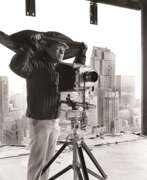

Ormond Gigli was an American photographer best known for his fashion and portrait photography. He was began his career as a freelance photographer in the 1940s, eventually becoming a staff photographer for several major publications, including LIFE, Time, and Harper's Bazaar.
Gigli's work is characterized by its striking use of color and composition, often featuring models in elaborate poses and settings. One of his most famous images is "Girls in the Windows," a photograph he took in 1960 of models posed in the windows of a Manhattan building slated for demolition.
Throughout his career, Gigli received numerous awards and accolades for his work, including the Lifetime Achievement Award from the American Society of Media Photographers in 2003. His photographs have been exhibited in galleries and museums around the world, and are held in the collections of many major institutions, including the Museum of Modern Art in New York and the National Portrait Gallery in Washington, D.C.


Nan Goldin is an acclaimed American photographer renowned for her profound visual narratives that delve into her personal world, marked by themes of addiction, sexuality, and intimate relationships. Born in Washington, D.C., in 1953, Goldin's journey into photography began in the early 1970s, capturing the lives of those around her, forming a "substitute family" amid a backdrop of drugs, sex, and violence.
One of Goldin's most celebrated works, "The Ballad of Sexual Dependency" (1986), is a raw and intimate portrayal of her "tribe," documenting their lives through the late 70s and early 80s in New York City. This work, initially presented as a slideshow, captures moments of love, sexuality, and domestic life, transcending into a poignant narrative of the era's challenges, particularly the AIDS crisis.
Throughout her career, Goldin's photography has continued to evolve, exploring various themes and mediums, including film. Her work, deeply personal and often autobiographical, challenges conventional perceptions of beauty, identity, and relationships, offering a window into the complexities of human connection and the essence of her subjects.
Goldin's influence extends beyond the art world, with her activism, particularly against the opioid crisis, marking another significant chapter in her journey. Her profound empathy and commitment to portraying the raw, unfiltered realities of life resonate through her extensive body of work, which continues to be celebrated in exhibitions and collections globally.
For art collectors and enthusiasts, Goldin's work offers not just aesthetic value but also deep emotional and historical resonance. To stay informed about Nan Goldin's works and related updates, signing up for newsletters from prominent galleries or her exhibitions could provide valuable insights and opportunities for engagement with her art.


Todd Hido is an American photographer and artist. He is best known for his moody and atmospheric photographs of suburban landscapes and homes, which often convey a sense of loneliness and isolation.
Hido's photographic style is characterized by his use of muted colors, soft lighting, and blurred images. He often photographs interiors and exteriors of homes at night, creating a dreamlike and eerie mood. His work is also known for its cinematic quality, and many of his images evoke the mood of film noir.
Hido's work has been exhibited in galleries and museums around the world, and his photographs have been published in numerous books and magazines. He has received many awards for his work, including a fellowship from the National Endowment for the Arts.
Hido's legacy as an artist and photographer continues to influence new generations of photographers and artists. His moody and evocative style has had a significant impact on the field of contemporary photography and has helped to redefine the way that we think about suburban landscapes and the concept of home.
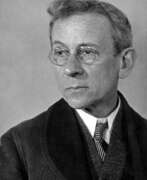

Lewis W. Hine was not an artist in the traditional sense, but rather a photographer and social documentary photographer who used his camera as a tool for social change. He is best known for his work in the early 20th century, documenting the living and working conditions of children in the United States.
Hine's photographs were instrumental in bringing about changes in child labor laws in the United States, and his images were used as evidence in court cases and Congressional hearings. He believed that photography could be a powerful tool for social reform, and he used his camera to highlight the injustices and hardships faced by working-class Americans.
In addition to his work as a photographer, Hine was also a teacher and an advocate for the arts. He taught at the Ethical Culture School in New York City, where he encouraged his students to use photography as a means of social commentary.
Hine's legacy as a photographer and social activist continues to inspire generations of artists and advocates for social justice. His photographs are considered a valuable historical record of life in the early 20th century, and his commitment to using art as a means of social change remains a powerful example of the role that artists can play in shaping society.


Dennis Lee Hopper was not only a prominent figure in the American film industry but also an accomplished photographer whose work captured the essence of a transformative era in the United States. Hopper's artistic journey spanned various mediums, with photography holding a special place in his array of talents. His photographic career, which began in earnest during the 1960s, offers a compelling glimpse into the cultural and social landscapes of the time.
Dennis Lee Hopper's photography is celebrated for its raw, candid portrayal of his surroundings, capturing moments that range from the intimate to the chaotic. His images provide a personal narrative of his life and times, reflecting his connections with key cultural and artistic figures of the era. His work is not just a collection of images but a visual diary, chronicling the vibrant and often tumultuous world he inhabited.
Notably, Dennis Lee Hopper's photographic portfolio offers an invaluable perspective on the American counterculture movement, showcasing his keen eye for composition and his ability to capture the spirit of the moment. His photographs, including portraits of famous contemporaries and snapshots of street scenes, resonate with authenticity and artistic integrity.
For collectors and enthusiasts in the realms of art and antiques, Dennis Lee Hopper's photographs represent a unique convergence of cinematic and photographic artistry. His works not only capture moments in time but also evoke the broader cultural shifts of his era. For those interested in exploring Hopper's photographic legacy, staying informed about exhibitions and auctions can provide opportunities to engage with his work more deeply and appreciate his contribution to the art of photography.
To stay updated on Dennis Lee Hopper's photographic works and related events, subscribing to updates from art galleries and auction houses is recommended. This subscription will provide timely information on new exhibitions, sales, and insights into Hopper's impact on the world of photography and art.


Horst P. Horst, a German-American fashion photographer, is renowned for his significant contributions to the art and fashion industry. Born in 1906, Horst's career spanned several decades, during which he became famous for his distinct style that skillfully blends elements of surrealism, classicism, and avant-garde artistry. His work, characterized by meticulous preparation and an innovative use of lighting, frequently avoided the use of filters and shadows, focusing instead on the subject with an almost architectural precision.
Horst P. Horst's legacy in fashion photography is underscored by his famous portraits, including the iconic 1942 image of Marlene Dietrich, and his exploration of the high society lifestyle through his collaborations with Vogue editor Diana Vreeland. These projects featured portraits of illustrious figures from the realms of royalty, art, fashion, and high society, such as Andy Warhol, Jacqueline Kennedy Onassis, and Yves Saint Laurent, showcasing Horst's ability to navigate the glamorous and intimate worlds of his subjects.
His work extended beyond portraiture to include interior design photography, as seen in his documentation of notable interiors for magazines like House & Garden and Vogue. Horst's photographs often served as a bridge, introducing the public to the works of contemporary artists and designers through his editorial and commercial assignments.
Throughout his career, Horst received critical acclaim, with major retrospectives of his work being held at prestigious venues such as the International Center of Photography in New York, the Louvre in Paris, and the National Gallery in London. These exhibitions highlighted his contributions to fashion, portraiture, and art photography, cementing his status as one of the most influential photographers of the 20th century.
For those interested in the evolution of fashion photography and the intersection of art and culture, Horst P. Horst's work remains a significant point of study and admiration. Collectors and experts in art and antiques are encouraged to explore his extensive portfolio, which continues to inspire and influence the fields of photography and fashion design.
If you wish to stay informed about upcoming sales and auction events related to Horst P. Horst, consider signing up for updates. This subscription will ensure you're at the forefront of the market for his enduring and captivating works.
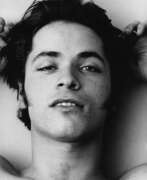

Peter Hujar was an American photographer best known for his black and white portraits. He has been recognized posthumously as a major American photographer of the late-twentieth century. Yet Hujar's work received only marginal public recognition during his lifetime.


Robert Hill Jackson or Bob Jackson is a Pulitzer Prize-winning American photographer.
Robert attended Southern Methodist University while pursuing a passion for photography. While serving in the National Guard, Jackson became a photographer for an Army general. In 1960, he began working as a photo reporter for the Dallas Times Herald newspaper.
On November 22, 1963, Jackson was assigned to cover President John F. Kennedy's arrival at Love Field and his motorcade through the city. He witnessed Kennedy's assassination, but did not have time to film it. Two days later, however, he was able to photograph the shooting of Lee Harvey Oswald, the accused assassin of President Lee Harvey Oswald, by Jack Ruby in the garage of the Dallas police station. Robert Jackson was awarded the 1964 Pulitzer Prize in Photography for these photographs.


Annie Leibovitz is an American photographer. She is one of the most well-known and highly regarded portrait photographers in the world, and her career spans over five decades.
Leibovitz began her career as a staff photographer for Rolling Stone magazine in 1970, where she quickly gained a reputation for her unique and intimate portraits of celebrities and musicians. She went on to work for Vanity Fair and Vogue magazines, where she continued to photograph some of the most famous and influential people of our time.
Leibovitz's distinctive style often involves using dramatic lighting, bold colors, and provocative poses to capture the essence of her subjects. Her work has been exhibited in museums and galleries around the world, and she has received numerous awards and honors for her contributions to the field of photography.
Some of Leibovitz's most famous photographs include the portrait of John Lennon and Yoko Ono, taken hours before Lennon's death, and the cover photo of a pregnant Demi Moore for Vanity Fair. Her photographs are often highly sought after and have been featured in many books and exhibitions.


Helen Levitt was an American photographer known for her street photography of New York City. Levitt began taking photographs as a teenager and went on to work for the photo agency, the Photo League, in the 1930s and 1940s.
Levitt's work focused on capturing the daily lives of ordinary people, particularly children, in the neighborhoods of New York City. She used a small 35mm camera to take candid shots of children playing in the streets, creating images that were both playful and poignant. Her work was often compared to the work of fellow street photographers, such as Henri Cartier-Bresson and Walker Evans.
In addition to her photography, Levitt also worked as a filmmaker and created several acclaimed documentaries.
Levitt's photographs have been exhibited in major museums around the world, including the Museum of Modern Art in New York and the San Francisco Museum of Modern Art. She was awarded numerous honors for her work, including a Guggenheim Fellowship and a National Endowment for the Arts Grant.


Vera Lutter is a German artist based in New York City. She works with several forms of digital media, including photography, projections, and video-sound installations. Through a multitude of processes, Lutter's oeuvre focuses on light and its ability to articulate the passing time and movement within a tangible image.


Christopher Makos is an American photographer and artist living and working in New York City.
Makos has traveled extensively in Europe, studied architecture in Paris, and studied with photographer Man Ray. In 1977 he met media artist and pop art star Andy Warhol and has been friends, traveled with him and photographed him extensively ever since. Makos published several acclaimed books on Warhol, and the latter called Makos "the most modern photographer in America."
In addition to him, Makos took photographic portraits of many art stars, including Elizabeth Taylor, Salvador Dali, John Lennon and Mick Jagger. His work has been published by many of the world's most famous magazines.


Robert Mapplethorpe was an American photographer, celebrated for his black-and-white photographs that captured a range of subjects including celebrity portraits, male and female nudes, self-portraits, and still-life images. Born in New York in 1946, Mapplethorpe's work is renowned for its technical precision, formal elegance, and controversial content, particularly his documentation of the gay male BDSM subculture and his erotic art. His body of work not only includes provocative themes but also more traditional subjects like flowers, showcasing his versatile artistic talent.
Robert Mapplethorpe's education at Pratt Institute in Brooklyn was foundational to his artistic journey, where he met Patti Smith and began his explorations in photography, initially through Polaroid camera use before advancing to more sophisticated techniques. His collaboration with Lisa Lyon, the first World Women's Bodybuilding Champion, and his retrospectives at significant institutions like the Whitney Museum of American Art highlight his broad artistic impact and continued influence in the art world. Despite his premature death in 1989 due to complications from AIDS, Mapplethorpe's legacy endures, supported by the Robert Mapplethorpe Foundation which promotes photography and funds medical research.
For collectors and experts in art and antiques, Robert Mapplethorpe's work remains a testament to the power of photography as a medium of both aesthetic beauty and provocative commentary. To stay updated on sales and auction events related to Robert Mapplethorpe's works, sign up for updates to not miss out on owning a piece of this influential artist's legacy.
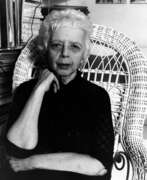

Lisette Model was an Austrian-born photographer who became known for her work in the United States in the mid-20th century. She was began her artistic career as a pianist before turning to photography.
Model's photographic style was characterized by her use of high-contrast black and white images and her interest in capturing the grit and energy of urban life. She often photographed people on the margins of society, such as street vendors, beggars, and nightclub performers, and her images were marked by a sense of empathy and intimacy with her subjects.
In addition to her work as a photographer, Model was also a teacher, and she taught photography at the New School for Social Research in New York City for many years. Her students included Diane Arbus and Bruce Weber, among others, and she was known for her direct and often challenging approach to teaching.
Model's work has had a significant impact on the field of photography, and her legacy continues to inspire new generations of artists. Her photographs are prized for their emotional intensity and their ability to capture the complexities of human experience, and she is remembered as one of the most important photographers of the 20th century.


Edward Ruscha, an American artist born in 1937, is a prominent figure associated with West Coast Pop art, celebrated for his innovative approach to blending visual and verbal language within his works. Ruscha's journey in the art world began after moving to Los Angeles in 1956, where his fascination with the urban landscape and commercial culture flourished. He attended Chouinard Art Institute, now known as CalArts, which laid the foundation for his artistic exploration.
Edward Ruscha's art is deeply influenced by the Hollywood film industry, with works like "Large Trademark with Eight Spotlights" echoing the commercial graphics and cinematic influence of his time. His "Word paintings" series, starting in the 1960s, showcases his unique approach to typography and language, setting monosyllabic words against solid backgrounds, a style that continued to evolve throughout his career.
During the 1970s, Edward Ruscha expanded his narrative, incorporating phrases into his works, further exploring the relationship between text and image. His work in the 1980s and beyond includes landscapes juxtaposed with text, creating intriguing visual narratives that challenge viewers to find connections between the words and the images.
Edward Ruscha's contributions to the art world are significant, with his works held in major collections and institutions. His career spans various mediums, including painting, printmaking, photography, and artist's books, showcasing his versatility and enduring influence on contemporary art.
For enthusiasts and collectors of modern art, Edward Ruscha's works offer a unique blend of visual artistry and linguistic play. His innovative approach to combining text and image has cemented his status as a pivotal figure in contemporary art. To stay updated on the latest exhibitions, sales, and insights related to Edward Ruscha's art, consider subscribing to updates from renowned art galleries and auction houses. This subscription will ensure you're informed about new opportunities to engage with and appreciate the distinct and influential art of Edward Ruscha.


David Seidner was an American photographer. He is best known for his work in the fields of fashion and fine art photography.
Seidner began his career in photography at the age of 19, when he was hired by Andy Warhol to shoot for Interview magazine. He went on to work for many other major publications, including Vogue, Harper's Bazaar, and The New Yorker.
Throughout his career, Seidner's work was characterized by its meticulous attention to detail, sophisticated use of light and shadow, and a focus on capturing the unique qualities and personalities of his subjects. He also experimented with alternative photographic processes and was known for his technical expertise.
Seidner's work has been exhibited in galleries and museums around the world, and he received numerous awards and honors for his contributions to the field of photography.


Laurie Simmons is an American artist, photographer and filmmaker. Since the mid-1970s, Simmons has staged scenes for her camera with dolls, ventriloquist dummies, objects on legs, and people, to create photographs that reference domestic scenes. She is part of The Pictures Generation, a name given to a group of artists who came to prominence in the 1970s. The Pictures Generation also includes Cindy Sherman, Barbara Kruger, and Louise Lawler.


Alec Soth is an American photographer. He is known for his large-format color photographs that often explore the themes of American life, culture, and landscape.
Soth began his career as a newspaper photographer before transitioning to fine art photography. He gained recognition for his project "Sleeping by the Mississippi," which features photographs of people and places along the Mississippi River.
Throughout his career, Soth has continued to produce photographic projects that explore various aspects of American life, from small towns to suburban communities. He has also published several books of his work, including "Songbook," "Broken Manual," and "I Know How Furiously Your Heart is Beating."
Soth's work has been exhibited widely and is included in the collections of many major museums, including the Museum of Modern Art in New York, the Whitney Museum of American Art, and the San Francisco Museum of Modern Art. He has also received numerous awards and honors for his photography, including a Guggenheim Fellowship, the Infinity Award from the International Center of Photography, and the Deutsche Börse Photography Foundation Prize.
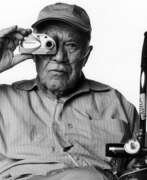

Philip "Snapdragon" Stern was an American photographer noted for his iconic portraits of Hollywood stars, as well as his war photography while serving as a U.S. Army Ranger with "Darby's Rangers" during the North African and Italian campaigns in World War II.


Bert Stern, real name Bertram Stern, is an American fashion photographer and documentary filmmaker.
His career began with the iconic and legendary Smirnoff Vodka advertising campaign in 1955. Using a well-equipped studio, Stern experimented with many of the latest techniques, including videotaping, screen printing, photo offset combinations and computer prints. His brilliant work made him a star in the advertising world, photographing advertising campaigns for Canon, Dupont, Pepsi-Cola, US Steel and Volkswagen brands. One of the high points of Bert Stern's career was working for Vogue in the 1960s.
Despite his drug addiction, the fashion photographer was sought after by Madison Avenue, Hollywood and the international fashion scene for decades.
Stern was one of the last photographers to shoot Marilyn Monroe in June and July 1962, six months before her death. Some of these photographs were published in Vogue magazine. In 1982, Bert Stern published The Last Sitting, a book that includes many of his more than 2,500 images, including those that Monroe did not like and were crossed out.
Stern directed and cinematographed the films Jazz on a Summer's Day (1959), A Date with an Angel (1987), and The Unknown Marilyn (2012).


Robert Stivers is an American photographer.
He became interested in photography at a mature age, after a career as a dancer and choreographer. Self-taught in the art of photography, Stivers prides himself on his printing skills. His photographs are printed on matte paper and are often tinted by hand or processed in a darkroom.
The aesthetics of early photography and silent film are evident in Stivers' work, helping the viewer immerse himself in a familiar but distant cultural unconscious. In his technique, the photographer uses defocused images, a blur of movement, to create a hazy vision of the world. In Stivers' photographs, the viewer sees ghostly images of dreams, where objects float and pose, or find themselves caught in the middle of a gesture that reflects his past history in dance.


Dennis Stock was an American photographer known for his iconic images of celebrities and musicians, as well as his extensive coverage of social issues and cultural events.
Stock began his career as a freelance photographer in the 1950s and was soon hired by the Magnum Photos agency, where he worked alongside other influential photographers such as Robert Capa and Henri Cartier-Bresson. He quickly became known for his photographs of jazz musicians, including Miles Davis, Louis Armstrong, and Duke Ellington.
In 1955, Stock received an assignment from LIFE magazine to photograph a young actor named James Dean. The resulting images, including a now-famous photograph of Dean walking through Times Square in the rain, became some of the most iconic photographs of the 20th century.
Stock continued to photograph celebrities and cultural figures throughout his career, including Audrey Hepburn, Marlon Brando, and Andy Warhol. He also covered major events such as the civil rights movement, the Vietnam War, and the Woodstock music festival.
Stock's work has been exhibited in galleries and museums around the world and has been the subject of several books and documentaries. He was known for his ability to capture intimate moments and his talent for revealing the personalities and emotions of his subjects through his photographs.


Jock Sturges is an American photographer living in Seattle, Washington.
After serving in the Army, Jock earned a Master of Arts degree from the San Francisco Art Institute and studied psychology. Diligently and extensively photographed teenagers on nude beaches in California, France or Ireland. This attracted the attention of law enforcement, but the artistic community of the United States and Europe spoke in defense of the photographer, and in the end he was not charged.
But after that Jock Sturges became popular: he published more than 10 personal albums, as a master of children's and teenage pictures he organized many solo exhibitions and took part in the same number of group exhibitions. However, these exhibitions were often accompanied by high-profile scandals, one of which happened in Russia in 2016: senators accused the photographer of distributing child pornography.


Larry Sultan was an American photographer and artist. He is known for his innovative and evocative photographic work that often explores the boundaries between documentary photography and staged narrative.
Sultan's work is characterized by his interest in the relationships between people and their environments, and he often incorporates everyday settings and objects into his photographs. He is perhaps best known for his seminal work, "Pictures from Home," which is a deeply personal exploration of his own family and their suburban life in Southern California.
Sultan's work has been exhibited in galleries and museums around the world, and he has received numerous awards and accolades for his contributions to the field of photography. He was also a highly respected teacher, and he taught photography at the California College of the Arts and other institutions for many years.
Sultan's legacy as an artist and photographer continues to influence new generations of artists. His innovative techniques and unique approach to photography have had a significant impact on the field of documentary photography, and his work remains an important contribution to the history of photography.


Bruce Weber is an American fashion photographer and occasional filmmaker. He has made ad campaigns for Calvin Klein, Ralph Lauren, Pirelli, Abercrombie & Fitch, Revlon, and Gianni Versace, and made work for Vogue, GQ, Vanity Fair, Elle, Life, Interview, and Rolling Stone magazines.


















































